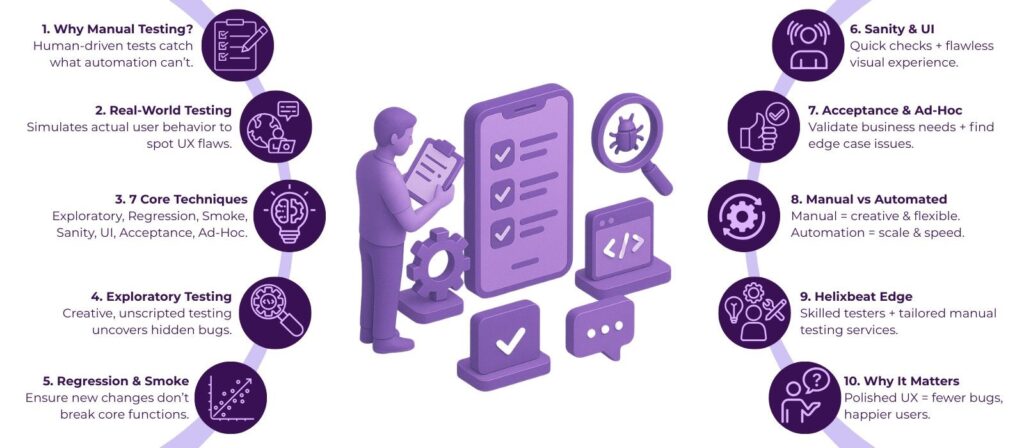In the tech industry, one of the biggest challenges is to make sure software works as expected across different environments and user scenarios. With constant updates, new features, and the pressure to meet deadlines, it’s easy for bugs to slip through the cracks.
To avoid such issues, many depend on manual software testing services. Unlike automated testing, which is great for repetitive tasks, manual testing involves real people diving into the software as end-users would. They spot issues that machines can’t, whether it’s a glitch in the user interface or an unexpected behaviour in a complex feature.
Manual testing brings that human touch, helping companies deliver a polished, bug-free product that truly meets user needs. Let’s see manual testing techniques in detail.

Table of Contents
Understand the Basics of Manual Testing
Before diving into the testing techniques, it’s important to understand what manual testing involves. It is the process where testers manually execute test cases without the use of automation tools. These services help identify defects early and ensure that the application meets the user’s expectations.
Manual testing allows testers to explore the application from a user’s perspective, focusing on functionality and usability. By relying on human intuition and experience, it uncovers issues that might not be detected by automated scripts.
Why is Manual Testing Mandatory Before Software Launch?
- Simulates Real-World User Behavior: Manual testing allows testers to interact with the software as end-users would, ensuring the application functions as expected in real-world scenarios.
- Identifies Issues Beyond Automation: Manual testers can identify visual glitches, usability problems, and performance issues that automated tests might overlook, such as design inconsistencies and user navigation problems.
- Human Judgment and Creativity: It leverages human intuition and experience to find defects that require critical thinking, which is essential for testing complex user interactions or workflows.
- Tests Non-Functional Aspects: Manual testing is crucial for evaluating user experience (UX), ensuring the software is intuitive, responsive, and engaging, which automated tests may not adequately assess.
- Flexibility in Testing Scenarios: Manual testers can adapt to new, unforeseen scenarios during testing, unlike automated tests, which follow predefined scripts and are limited to their programmed scope.
- Mitigates Risk of Critical Bugs: Without manual testing, bugs that affect user experience may go undetected, which could result in poor user satisfaction and a negative impact post-launch.
Top 7 Manual Testing Techniques for QA Teams
1. Exploratory Testing
In exploratory testing, testers explore the application without predefined test cases, relying on their creativity, intuition, and experience to find defects. Testers interact with the application and decide on the fly what to test next.
Example: A tester might navigate through an e-commerce website, trying various combinations of actions like adding items to the cart, applying discount codes, and checking out. In this process, they might uncover a bug that occurs when applying multiple discount codes, which automated tests might miss.
2. Regression Testing
Regression testing ensures that new changes in the software (such as bug fixes or new features) do not negatively impact existing functionality. This is particularly useful when there are frequent updates to the software.
Example: After adding a new payment gateway integration to a banking app, a tester manually checks whether other functionalities like balance checking, money transfer, and transaction history still work as expected.
3. Smoke Testing
Smoke testing is a quick check to determine whether the core functionalities of the software are working. It’s often referred to as a “sanity check” to ensure the build is stable enough for further testing.
Example: For a newly built mobile app, testers manually verify that the app opens without crashing, the login screen functions, and basic navigation is operational. If these core functionalities fail, the testing stops here.
4. Sanity Testing
Sanity testing is a focused type of testing that checks a specific area or functionality after a major bug fix or update to ensure that the issue is resolved without introducing new defects.
Example: After fixing a bug where a user couldn’t update their profile in a social media app, a tester manually checks the profile update feature to confirm it now works without re-testing the entire app.
5. User Interface (UI) Testing
UI testing ensures that the visual elements of the application are displayed as expected. Testers check for alignment, color schemes, font sizes, and user interactions, ensuring that the application is user-friendly.
Example: A tester manually checks the positioning of buttons, the text in drop-down menus, and the responsiveness of the layout when the screen size changes on a website. They also ensure that form elements are functional and visually consistent across devices.
6. Acceptance Testing
Acceptance testing is done to verify whether the software meets the business requirements and is ready for release. It’s often done by the end-users or clients to confirm that the product aligns with their needs.
Example: A healthcare management system is being tested for launch, and a tester verifies that the patient scheduling feature works as required by the medical facility’s workflow. This involves manually testing the feature against specific acceptance criteria provided by the client.
7. Ad-Hoc Testing
Ad-hoc testing is informal and unstructured. Testers don’t follow specific test cases but instead, randomly test the software to uncover defects. It’s useful for finding unexpected issues that may not be caught by formal test cases.
Example: A tester might randomly click through a mobile app, trying out different features and entering random data. For example, they might enter special characters in a text field to check if the app handles it properly, something that was not specifically planned in test cases.
These techniques are critical for ensuring software quality from a human perspective, and each method serves a unique purpose in the overall testing process. Manual testing is essential in scenarios where user interaction, visual elements, and creative problem-solving are involved.
What makes Manual testing different from Automated Testing
1. Human Judgment and Creativity
Manual testing relies heavily on the tester’s intuition, creativity, and critical thinking. Testers can adapt to changing scenarios, explore new workflows, and simulate real-world user behavior in ways that automated tests cannot.
This makes manual testing especially valuable for testing aspects like user experience (UX) and identifying issues related to design, usability, and unexpected user interactions.
2. Flexibility and Adaptability
Manual testing provides flexibility because testers can adjust their approach based on the results of their testing.
For instance, if a tester discovers an unforeseen issue, they can immediately shift focus to examine related areas of the application without waiting for pre-written scripts to catch up.
3. Efficiency vs. Scale
Automated testing excels at repetitive, large-scale tasks. It’s perfect for regression testing and running a large number of tests quickly and repeatedly without human intervention.
However, it lacks the ability to evaluate new or complex interactions that might arise, especially when the application’s behavior is not predefined.Manual testing, on the other hand, is more time-consuming but excels at catching these issues and evaluating intricate, subjective elements.
Why Helixbeat is the Best Choice for Manual Testing Services
At Helixbeat, we offer manual testing services around the world, which is efficient and cost-effective. With a team of highly skilled testers, we make sure thorough testing with personalized attention for your software. Our manual software testing services help detect potential issues before they impact users, making us the perfect partner for all your testing needs.
What Makes Us Unique From Others
- Skilled professionals with certifications and extensive experience.
- Custom testing services based on your unique project needs.
- Full testing, from exploratory to UI validation.
- Efficient testing with fast delivery of results.
Contact us today for quality manual testing services that will help you spot issues before they affect your users. Let’s work together to create flawless applications.
FAQ:
1. What is the fee for manual testing?
The fee for manual testing can vary based on factors like the complexity of the project, the scope of testing, and the number of test cases. Generally, the cost depends on the testing provider and the level of expertise required. It’s best to request a quote tailored to your specific requirements.
2. Which is the best tool for manual testing?
The best tool depends on the software being tested. Popular options include JIRA for bug tracking, TestRail for managing test cases, and Bugzilla for issue tracking, which helps streamline the manual testing process.
3. Is manual testing in demand?
Yes, manual testing is still in demand, especially for applications requiring human judgment, user interface validation, and real-world scenarios. While automated testing is growing in popularity, manual testing remains essential for ensuring software quality, especially for complex systems and user-driven applications.
4. Is manual testing easy?
Manual testing is not necessarily easy. It requires a keen eye for detail, creativity, and a deep understanding of the software being tested. Testers must think critically, simulate real-world scenarios, and be adaptable to unexpected issues. While it doesn’t require automation skills, it still demands precision and thoroughness.
5. How can we improve the manual testing process?
To improve manual testing, ensure clear and organized test cases, maintain communication between developers and testers, encourage knowledge sharing, and stay updated on trends. Involving testers early helps identify issues sooner.














